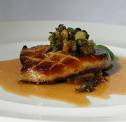Is Foie Gras Junk Food?
Tuesday, June 17, 2008 Yesterday, I gave a talk to Alberta Agriculture on my take of the obesity epidemic(thanks to Annette for the invitation) . Obviously, the best way to influence policy is to talk to policy makers, so an opportunity to present my views to policy makers is always appreciated.
Yesterday, I gave a talk to Alberta Agriculture on my take of the obesity epidemic(thanks to Annette for the invitation) . Obviously, the best way to influence policy is to talk to policy makers, so an opportunity to present my views to policy makers is always appreciated.
Given that the audience was keenly interested in issues related to nutrition, it was not surprising that questions arose around the issue of junk food (actually this topic comes up at virtually every talk on obesity).
The discussion again made obvios the difficulty of the concept of junk food – i.e., when exactly is food junk? Now obviously, from an obesity perspective any form of “empty” calories would constitute junk food, that one is easy. But what about real food with more than just calories?
When I look to Wikipedia for a definition, I find the following (slightly paraphrased for brevity):
“Junk food is food that is unhealthy and/or has little or no nutritional value. It contains high levels of refined sugar, white flour, trans fat and polyunsaturated fat, salt, and numerous food additives such as monosodium glutamate and tartrazine; at the same time, it is lacking in proteins, vitamins and fiber, among other healthy attributes. It is popular because it is easy to purchase, requires little or no preparation, is convenient to consume and has lots of flavor. ”
Clear enough, you’d think.
But the same post in Wikipedia also says why this definition is not easy (again paraphrased for brevity):
“What constitutes unhealthy food may be confusing and, according to critics, includes elements of class snobbery, cultural influence and moral judgement. For example, fast food in North America, such as as hamburgers and french fries supplied by companies like McDonald’s, KFC and Pizza Hut, are often perceived as junk food, whereas the same meals supplied by more up-market outlets such as California Pizza Kitchen or Nando’s are not, despite often having the same or worse nutritional content. Some foods that are considered ethnic or traditional are not generally considered junk food, such as falafel, gyro, pakora, gyoza or chicharron, though all of these foods have little nutritional value and are usually high in fat from being fried in oil. Other foods such as white rice, roast potatoes and processed white bread are not considered junk food despite having limited nutritional content compared to wholegrain foods. Similarly, breakfast cereals are often regarded as healthy but may have high levels of sugar, salt and fat.“
So the question is, “what exactly constitutes junk food?”. If French fries from McDonalds are junk food because they contain little nutritional value, what about the over priced “hand cut” deli fried served in high-class restaurants? Does charging more money make junk food less “junkie”? What about foods like foie gras, caviar, lard – foods with no nutritional value, but eaten simply for their taste? Are these junk foods?
I sure do not envy the policy makers who have to decide what exactly constitutes “junk” food and where exactly to draw the line for healthy vs. unhealthy foods (e.g. Exactly how many calories per gram of food are admissable caloric density? How much refined sugar/sodium/fat per what are acceptable? Are all fried foods automatically junk food? Does throwing in some vitamins, protein and fibre make an unhealthy food healthier? etc.).
Not questions that I want to answer or take a stand on.
As I blogged before, in the context of obesity it’s the calories that count – discussing nutrients is out of my league.
AMS
Edmonton, Alberta


